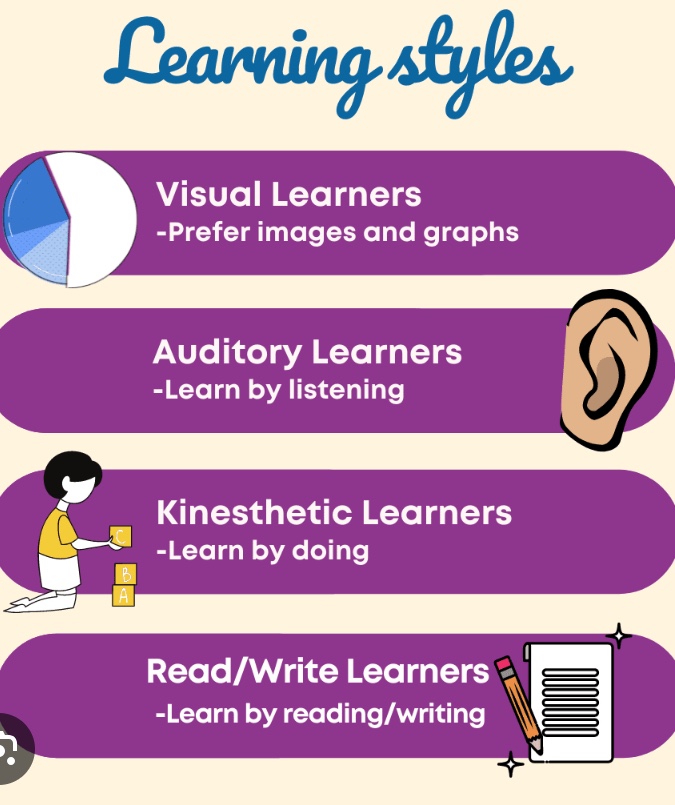My big topic inquiry question is how does an assistant teacher affect the classroom environment? This big topic question will have implications on a global level because 90% of the world has completed a primary education. This shows that many people are interested in learning! I hope to increase the learning in classrooms, so that the students can have greater access for guidance and help. I hope to also help students learn effectively. I hear many students saying that they spend so much time (almost more than five hours studying.) However, they do not get the mark they think they deserve on the tests. I hope to research more on how to productively study, so we can improve our test scores.
My sub-topic question is what are the 4 different learning styles? I would like to research more on the 4 different learning styles because I hope to find more strategies to study. I will explain the strategies of learning for a visual learner, auditory learner, kinesthetic learner and reading/writing learner. I hope to implement a variety of all these strategies in my learning process. I also realized that teaching styles are reflective by the teacher’s learning styles. I hope to help teachers implement an effective learning environment in the class, so the students can stay motivated while learning.

Visual learners like to see and make diagrams and images to explain their research. They like to highlight their notes to organize them (1). They learn best when they see how to do a task (1). They usually have photographic memory and use colors, tones, and brightness to easily remember their work (1). Some strategies to learn if you are a visual learner are have your eyesight checked regularly, use flashcards and visualize images when words are read (1). Furthermore, it is important to include key words in notes, draw pictures, use color, and avoid distractions while doing homework (1).

Auditory learners learn best while hearing and listening information (2). They recall information by how it sounds instead of seeing them on paper (3). They are great communicators and love to read out loud. They love to listen to music and podcasts during their breaks (4). Some techniques for them is to go often for a hearing checkup, read information out loud if they are not clear and listen to recordings of information (4). Another technique is to ask a friend to talk about test materials because it will be easier to memorize facts (4).

Kinesthetic learners appreciate retaining information by touching materials and exercising (5). They benefit from physical activity and study breaks to refresh their minds. They often speak with their hands when presenting information (5). They also have great recollection of what was made by their hands. One of an effective way to study is to participate in many hands-on activities like origami, painting, and drawing (6). It is also important to incorporate physical activities when studying for a test. For example, talking a walk, stretching, or playing soccer (6). It is also a great idea to chew gum, stand up and move your wrists when studying to feel less tired (6).
Reading/Writing learners grasp information by writing, reading, rewriting, and rereading information (7). They love to add notes to their pictures to help them remember the image (7). They learn best with textbooks and thesauruses instead of audiobooks or pictures (7). They enjoy reading a variety of books like fantasy, romance, or mystery (7). Some techniques for reading/writing learners are writing a mind map, organizing long notes, and reading note card (7).

Students can use many of these techniques because you can be many different types of learners at once. For example, this learning style quiz (https://www.learningstylequiz.com/?gclid=CjwKCAjwoa2xBhACEiwA1sb1BBruwE6igovbmYTA1uv2WMYcLSd0YtOp8XFfw5urtxyFsxvX-O_KNhoCV18QAvD_BwE) helped me realize that I am 60% visual, 20% auditory and 20% kinesthetic! I hope this blog post helps teachers to provide many different learning tools to students. For example, they can share information using podcasts, notes or even some diagrams.

I will next be researching on: what are the roles of an assistant teacher? I am interested in becoming a teacher. One of the steps to becoming a teacher is becoming an assistant teacher. Therefore, I am hoping to learn about the roles of an assistant teacher because it is the milestone before becoming a teacher. Many of my peers are also interested in becoming a teacher, so I hope to help them decide if teaching is a job for them. I have met many assistant teachers during my elementary school, middle school, and high school years. I noticed their roles vary depending on the grade levels, so I am curious how their role differs between the grades. This will help me answer my inquiry question of how an assistant teacher affects the classroom because I will be able to learn if their roles are relevant to the students. For example, if they help plan lessons, they will positively affect the classroom. However, if assistant teachers are not required to interact with students nor the classroom teachers, they may not be necessary to the classroom.
[ALL SOURCES ARE PEER-REVIEWED]:
1)8 Types of Learning Styles | The Definitive Guide. 7 Mar. 2024, https://bau.edu/blog/types-of-learning-styles/.
2)“4 Types of Learning Styles: How to Accommodate a Diverse Group Of.” Rasmussen University, https://www.rasmussen.edu/degrees/education/blog/types-of-learning-styles/. Accessed 26 Apr. 2024.
3)Morganelli, Dr Marie. Types of Learning Styles: The Value in Holistic Strategies. 18 Oct. 2023, https://www.snhu.edu/about-us/newsroom/education/types-of-learning-styles.
4) How to Study for Exams. https://www.princetonreview.com/college-advice/how-to-study-for-exams. Accessed 26 Apr. 2024.
5) nair, madhu. “How to Study for Exams: Strategies and Tips You Must Know.” University of the People, 13 Aug. 2019, https://www.uopeople.edu/blog/how-to-study-for-exams-strategies-and-tips/.
6) How to Study Efficiently and Effectively | SFU Library. https://www.lib.sfu.ca/about/branches-depts/slc/learning/exam-prep/efficient-effective-study. Accessed 26 Apr. 2024.
7)“Studying 101: Study Smarter Not Harder.” Learning Center, https://learningcenter.unc.edu/tips-and-tools/studying-101-study-smarter-not-harder/. Accessed 26 Apr. 2024.
Thank you for reading my post,
Sarah Kim



Hey Sarah,
Great blog post!
I really liked how you explained each of the four learning styles. I recently have realized that I am more of an auditory learner as I repeat subjects out loud as if I’m teaching it to someone, and that helps me better understand concepts (as you mentioned). So I find these learning styles very interesting!
I do think that it is necessary to know the different types of learning styles in order to see how assistant teachers can help students with different learning styles, and thus how they affect the classroom environment.
I do wonder if assistant teachers can help make the classroom more atonable to suit students with different learning styles?
https://sprottshaw.com/blog/reasons-why-education-assistants-are-important/
https://fontenebroschool.com/en/the-importance-of-teaching-assistants-in-the-classroom-2/
These sources should help find an answer to this question, as well as help you with your research about student teacher’s impact in the classroom.
Looking forward to your future blog posts!
Sevin